Spray-Drying Impact the Physicochemical Properties and Formation of Maillard Reaction Products Contributing to Antioxidant Activity of Camelina Press Cake Extract
Abstract
1. Introduction
2. Materials and Methods
2.1. Materials
2.2. Obtaining the Camelina Press Cake Extract
2.3. Spray-Drying Protocol
2.4. Powder Characterization
2.4.1. Solubility in Water and Total Solid Content
2.4.2. Flowability and Cohesiveness of Powders
2.4.3. Water Activity Evaluation
2.4.4. Determination of Powders Morphology
2.4.5. Reconstitution of Camelina Press Cake Extract (CPE)
2.4.6. Particle Size Distribution of Powders and Extracts
2.4.7. Determination of pH, Titratable Acidity (TA)
2.4.8. Instrumental Color Determination
2.5. Determination of Sulfhydryl Groups (–SH) and Disulfide Bonds (–S–S–) Contents in Spray-Dried Powders
2.6. Evaluation of Early, Advanced and Final Stage of Maillard Reaction (MR)
2.7. FTIR Analyses
2.8. Rheological Measurments
2.9. Determination of the Reducing Sugars Content (RSC), Total Free Amino Acids (TFAA), Total Polyphenols Content (TPC) and Total Flavonoids Content (TFC)
2.10. Changes in Antioxidant Proprities
2.11. Statistical Analyses
3. Results and Discussion
3.1. Powders Characteristics
3.2. Characterization of the Samples before and after Reconstitution
3.3. Rheological Changes before and after Reconstitution
4. Conclusions
Author Contributions
Funding
Institutional Review Board Statement
Informed Consent Statement
Data Availability Statement
Acknowledgments
Conflicts of Interest
References
- Sapone, A.; Bai, J.C.; Ciacci, C.; Dolinsek, J.; Green, P.H.R.; Hadjivassiliou, M.; Kaukinen, K.; Rostami, K.; Sanders, D.S.; Schumann, M.; et al. Spectrum of gluten-related disorders: Consensus on new nomenclature and classification. BMC Med. 2012, 10, 13. [Google Scholar] [CrossRef] [PubMed]
- Lebwohl, B.; Sanders, D.S.; Green, P.H.R. Coeliac Disease. Lancet 2018, 391, 70–81. [Google Scholar] [CrossRef] [PubMed]
- Molina-Infante, J.; Santolaria, S.; Sanders, D.S.; Fernández-Bañares, F. Systematic review: Noncoeliac Gluten Sensitivity. Aliment. Pharmacol. Ther. 2015, 41, 807–820. [Google Scholar] [CrossRef]
- Rowicka, G.; Czaja-Bulsa, G.; Chełchowska, M.; Riahi, A.; Strucińska, M.; Weker, H.; Ambroszkiewicz, J. Oxidative and antioxidative status of children with celiac disease treated with a gluten free-diet. Oxid. Med. Cell Longev. 2018, 2018, 1324820. [Google Scholar] [CrossRef] [PubMed]
- Calabriso, N.; Scoditti, E.; Massaro, M.; Maffia, M.; Chieppa, M.; Laddomada, B.; Carluccio, M.A. Non-celiac gluten sensitivity and protective role of dietary polyphenols. Nutrients 2022, 14, 2679. [Google Scholar] [CrossRef] [PubMed]
- Kurasiak-Popowska, D.; Rynska, B.; Stuper-Szablewska, K. Analysis of distribution of selected bioactive compounds in Camelina sativa from seeds to pomace and oil. Agronomy 2019, 9, 168. [Google Scholar] [CrossRef]
- Terpinc, P.; Polak, T.; Makuc, D.; Ulrih, N.P.; Abramovič, H. The occurrence and characterisation of phenolic compounds in Camelina sativa seed, cake and oil. Food Chem. 2012, 131, 580–589. [Google Scholar] [CrossRef]
- Sarv, V.; Trass, O.; Diosady, L.L. Preparation and characterization of Camelina sativa protein isolates and mucilage. JAOCS 2017, 94, 1279–1285. [Google Scholar] [CrossRef]
- Li, N.; Qi, G.; Sun, X.S.; Wang, D. Characterization of gum isolated from camelina seed. Ind. Crops Prod. 2016, 83, 268–274. [Google Scholar] [CrossRef]
- Łopusiewicz, Ł.; Drozłowska, E.; Kwiatkowski, P. Production and characterization of yogurt-like fermented beverage based on Camelina (Camelina Sativa L.) seed press cake. Appl. Sci. 2022, 12, 1085. [Google Scholar] [CrossRef]
- Usman, I.; Saif, H.; Imran, A.; Afzaal, M.; Saeed, F.; Azam, I.; Afzal, A.; Ateeq, H.; Islam, F.; Shah, Y.A.; et al. Innovative applications and therapeutic potential of oilseeds and their by-products: An eco-friendly and sustainable approach. Food Sci. Nutr. 2023, 1–11. [Google Scholar] [CrossRef]
- Arrutia, F.; Binner, E.; Williams, P.; Waldron, K.W. Oilseeds beyond oil: Press cakes and meals supplying global protein requirements. Trends Food Sci. Technol. 2020, 100, 88–102. [Google Scholar] [CrossRef]
- Ancuţa, P.; Sonia, A. Oil press-cakes and meals valorization through circular economy approaches: A review. Appl. Sci. 2020, 10, 7432. [Google Scholar] [CrossRef]
- Samborska, K.; Boostani, S.; Geranpour, M.; Hosseini, H.; Dima, C.; Khoshnoudi-Nia, S.; Rostamabadi, H.; Falsafi, S.R.; Shaddel, R.; Akbari-Alavijeh, S.; et al. Green biopolymers from by-products as wall materials for spray drying microencapsulation of phytochemicals. Trends Food Sci. Technol. 2021, 108, 297–325. [Google Scholar] [CrossRef]
- León-Martínez, F.M.; Rodríguez-Ramírez, J.; Medina-Torres, L.L.; Méndez Lagunas, L.L.; Bernad-Bernad, M.J. Effects of drying conditions on the rheological properties of reconstituted mucilage solutions (Opuntia ficusindica). Carbohydr. Polym. 2011, 84, 439–445. [Google Scholar] [CrossRef]
- Drozłowska, E.; Łopusiewicz, Ł.; Mężyńska, M.; Bartkowiak, A. Valorization of flaxseed oil cake residual from cold-press oil production as a material for preparation of spray-dried functional powders for food applications as emulsion stabilizers. Biomolecules 2020, 10, 153. [Google Scholar] [CrossRef]
- Bustamante, M.; Laurie-Martínez, L.; Vergara, D.; Campos-Vega, R.; Rubilar, M.; Shene, C. Effect of three polysaccharides (inulin, and mucilage from chia and flax seeds) on the survival of probiotic bacteria encapsulated by spray drying. Appl. Sci. 2020, 10, 4623. [Google Scholar] [CrossRef]
- Lipan, L.; Rusu, B.; Sendra, E.; Hernández, F.; Vázquez-Araújo, L.; Vodnar, D.C.; Carbonell-Barrachina, Á.A. Spray drying and storage of probiotic-enriched almond milk: Probiotic survival and physicochemical properties. J. Sci. Food Agric. 2020, 100, 3697–3708. [Google Scholar] [CrossRef]
- Jinapong, N.; Suphantharika, M.; Jamnong, P. Production of instant soymilk powders by ultrafiltration, spray drying and fluidized bed agglomeration. J. Food Eng. 2008, 84, 194–205. [Google Scholar] [CrossRef]
- Wilkowska, A.; Ambroziak, W.; Czyżowska, A.; Adamiec, J. Effect of microencapsulation by spray-drying and freeze-drying technique on the antioxidant properties of blueberry (Vaccinium myrtillus) juice polyphenolic compounds. Pol. J. Food Nutr. Sci. 2016, 66, 11–16. [Google Scholar] [CrossRef]
- Ibrahim, F.M.; Habbasha, E. Chemical composition, medicinal impacts and cultivation of camelina (Camelina sativa): Review. Int. J. Pharm. Tech. Res. 2015, 8, 114–122. [Google Scholar]
- Łopusiewicz, Ł.; Drozłowska, E.; Tarnowiecka-Kuca, A.; Bartkowiak, A.; Mazurkiewicz-Zapałowicz, K.; Salachna, P. Biotransformation of flaxseed oil cake into bioactive camembert-analogue using Lactic Acid Bacteria, Penicillium camemberti and Geotrichum candidum. Microorganisms 2020, 8, 1266. [Google Scholar] [CrossRef] [PubMed]
- Horwitz, W. Official Methods of Analysis of AOAC International, 17th ed.; AOAC International: Gaithersburg, MD, USA, 2000. [Google Scholar]
- Drozłowska, E.; Bartkowiak, A.; Trocer, P.; Kostek, M.; Tarnowiecka-Kuca, A.; Łopusiewicz, Ł. Formulation and evaluation of spray-dried reconstituted flaxseed oil-in-water emulsions based on flaxseed oil cake extract as emulsifying and stabilizing agent. Foods 2021, 10, 256. [Google Scholar] [CrossRef]
- Gong, K.J.; Shi, A.M.; Liu, H.Z.; Liu, L.; Hu, H.; Adhikari, B.; Wang, Q. Emulsifying properties and structure changes of spray and freeze-dried peanut protein isolate. J. Food Eng. 2015, 170, 33–40. [Google Scholar] [CrossRef]
- Gierczyński, I.; Guichard, E.; Laboure, H. Aroma perception in dairy products: The roles of texture, aroma release, and consumer physiology. A review. Flavour Fragr. J. 2011, 26, 141–152. [Google Scholar] [CrossRef]
- Carr, L.R. Evaluating flow properties of solids. Chem. Eng. 1965, 18, 163–168. [Google Scholar]
- Hausner, H.H. Friction conditions in a mass of metal powder. Int. J. Powder Metall. 1967, 3, 7–13. [Google Scholar]
- Łopusiewicz, Ł.; Waszkowiak, K.; Polanowska, K.; Mikołajczak, B.; Śmietana, N.; Hrebień-Filisińska, A.; Sadowska, J.; Mazurkiewicz-Zapałowicz, K.; Drozłowska, E. The effect of yogurt and kefir starter cultures on bioactivity of fermented industrial by-product from Cannabis sativa production—Hemp press cake. Fermentation 2022, 8, 100490. [Google Scholar] [CrossRef]
- Drozłowska, E.; Bartkowiak, A.; Trocer, P.; Kostek, M.; Tarnowiecka-Kuca, A.; Bienkiewicz, G.; Łopusiewicz, Ł. The influence of flaxseed oil cake extract on oxidative stability of microencapsulated flaxseed oil in spray-dried powders. Antioxidants 2021, 10, 211. [Google Scholar] [CrossRef]
- Michalska, A.; Amigo-Benavent, M.; Zielinski, H.; Del Castillo, M.D. Effect of bread making on formation of Maillard reaction products contributing to the overall antioxidant activity of rye bread. J. Cereal Sci. 2008, 48, 123–132. [Google Scholar] [CrossRef]
- Zieliński, H.; Del Castillo, M.D.; Przygodzka, M.; Ciesarova, Z.; Kukurova, K.; Zielińska, D. Changes in chemical composition and antioxidative properties of rye ginger cakes during their shelf-life. Food Chem. 2012, 135, 2965–2973. [Google Scholar] [CrossRef] [PubMed]
- Łopusiewicz, Ł.; Drozłowska, E.; Siedlecka, P.; Mężyńska, M.; Bartkowiak, A.; Sienkiewicz, M.; Zielińska-Bliźniewska, H.; Kwiatkowski, P. Development, characterization, and bioactivity of non-dairy kefir-like fermented beverage based on flaxseed oil cake. Foods 2019, 8, 544. [Google Scholar] [CrossRef] [PubMed]
- Barac, M.; Cabrilo, S.; Pesic, M.; Stanojevic, S.; Zilic, S.; Macej, O.; Ristic, N. Profile and functional properties of seed proteins from six pea (Pisum sativum) genotypes. Int. J. Mol. Sci. 2010, 11, 4973–4990. [Google Scholar] [CrossRef] [PubMed]
- Tong, T.; Liu, Y.J.; Kang, J.; Zhang, C.M.; Kang, S.G. Antioxidant activity and main chemical components of a novel fermented tea. Molecules 2019, 24, 2917. [Google Scholar] [CrossRef] [PubMed]
- Guo, C.; Yang, J.; Wei, J.; Li, Y.; Xu, J.; Jiang, Y. Antioxidant activities of peel, pulp and seed fractions of common fruits as determined by FRAP assay. Nutr. Res. 2003, 23, 1719–1726. [Google Scholar] [CrossRef]
- Reddy, R.S.; Ramachandra, C.T.; Hiregoudar, S.; Nidoni, U.; Ram, J.; Kammar, M. Influence of processing conditions on functional and reconstitution properties of milk powder made from Osmanabadi goat milk by spray drying. Small Rumin. Res. 2014, 119, 130–137. [Google Scholar] [CrossRef]
- Fitzpatrick, J.J.; Iqbal, T.; Delaney, C.; Twomey, T.; Keogh, M.K. Effect of powder properties and storage conditions on the flowability of milk powders with different fat contents. J. Food Eng. 2004, 64, 435–444. [Google Scholar] [CrossRef]
- Łopusiewicz, Ł.; Bogusławska-Wąs, E.; Drozłowska, E.; Trocer, P.; Dłubała, A.; Mazurkiewicz-Zapałowicz, K.; Bartkowiak, A. The application of spray-dried and reconstituted flaxseed oil cake extract as encapsulating material and carrier for probiotic Lacticaseibacillus rhamnosus GG. Materials 2021, 14, 5324. [Google Scholar] [CrossRef]
- Zhong, C.; Tan, S.; Zhou, Z.; Zhong, X.; Langrish, T. Applications of aged powders of spray-dried whey protein isolate and ascorbic acid in the field of food safety. Dry. Technol. 2023, 1–11. [Google Scholar] [CrossRef]
- Akbarbaglu, Z.; Mahdi Jafari, S.; Sarabandi, K.; Mohammadi, M.; Khakbaz Heshmati, M.; Pezeshki, A. Influence of spray drying encapsulation on the retention of antioxidant properties and microstructure of flaxseed protein hydrolysates. Colloids Surf. B Biointerfaces 2019, 178, 421–429. [Google Scholar] [CrossRef]
- Sadiq, U.; Gill, H.; Chandrapala, J.; Shahid, F. Influence of spray drying on encapsulation efficiencies and structure of casein micelles loaded with anthraquinones extracted from Aloe vera plant. Appl. Sci. 2023, 13, 110. [Google Scholar] [CrossRef]
- Boostani, S.; Aminlari, M.; Moosavi-nasab, M.; Niakosari, M.; Mesbahi, G. Fabrication and characterisation of soy protein isolate-grafted dextran biopolymer: A novel ingredient in spray-dried soy beverage formulation. Int. J. Biol. Macromol. 2017, 102, 297–307. [Google Scholar] [CrossRef] [PubMed]
- Fu, G.M.; Xu, Z.W.; Luo, C.; Xu, L.Y.; Chen, Y.R.; Guo, S.L.; Wu, X.D.; Wan, Y. Modification of soy protein isolate by Maillard reaction and its application in microencapsulation of Limosilactobacillus reuteri. J. Biosci. Bioeng. 2021, 132, 343–350. [Google Scholar] [CrossRef] [PubMed]
- Fang, Y.; Rogers, S.; Selomulya, C.; Chen, X.D. Functionality of milk protein concentrate: Effect of spray drying temperature. Biochem. Eng. J. 2012, 62, 101–105. [Google Scholar] [CrossRef]
- Liu, D.; Zhang, J.; Yang, T.; Liu, X.; Hemar, Y.; Regenstein, J.M.; Zhou, P. Effects of skim milk pre-acidification and retentate pH-restoration on spray-drying performance, physico-chemical and functional properties of milk protein concentrates. Food Chem. 2019, 272, 539–548. [Google Scholar] [CrossRef]
- Starowicz, M.; Zielinski, H. Functional properties and Maillard reaction product formation in rye-buckwheat ginger cakes enhanced with rutin. In Superfood and Functional Food—An Overview of Their Processing and Utilization; InTech: Rijeka, Croatia, 2017. [Google Scholar]
- Langner, E.; Rzeski, W. Biological properties of melanoidins: A review. Int. J. Food Prop. 2014, 17, 344–353. [Google Scholar] [CrossRef]
- Souza, C.R.F.; Georgetti, S.R.; Salvador, M.J.; Vieira Fonseca, M.J.; Pereira Oliveira, W. Antioxidant activity and physical-chemical properties of spray and spouted bed dried extracts of Bauhinia forficate. Braz. J. Pharm. Sci. 2009, 45, 209–218. [Google Scholar] [CrossRef]
- Ali, H.; Al-khalifa, A.R.; Aboelsood, W.; Bareh, G.; Farouk, A. Influence of spray-drying on improving the quality of dried carob juice. Qual. Assur. Saf. 2019, 11, 391–399. [Google Scholar] [CrossRef]
- Wu, G.; Hui, X.; Mu, J.; Brennan, M.A.; Brennan, C.S. Functionalization of whey protein isolate fortified with blackcurrant concentrate by spray-drying and freeze-drying strategies. Int. Food Res. J. 2021, 141, 110025. [Google Scholar] [CrossRef]
- Pérez-Gregorio, M.R.; Regueiro, J.; González-Barreiro, C.; Rial-Otero, R.; Simal-Gándara, J. Changes in antioxidant flavonoids during freeze-drying of red onions and subsequent storage. Food Control 2011, 22, 1108–1113. [Google Scholar] [CrossRef]
- Rodrigues, L.A.; Matias, A.A.; Paiva, A. Recovery of antioxidant protein hydrolysates from shellfish waste streams using subcritical water extraction. Food Bioprod. Process 2021, 130, 154–163. [Google Scholar] [CrossRef]
- Mrkìc, V.; Cocci, E.; Dalla Rosa, M.; Sacchetti, G. Effect of drying conditions on bioactive compounds and antioxidant activity of broccoli (Brassica oleracea L.). J. Sci. Food Agric. 2006, 86, 1559–1566. [Google Scholar] [CrossRef]
- Papoutsis, K.; Golding, J.B.; Vuong, Q.; Pristijono, P.; Stathopoulos, C.E.; Scarlett, C.J.; Bowyer, M. Encapsulation of citrus by-product extracts by spray-drying and freeze-drying using combinations of maltodextrin with soybean protein and L-Carrageenan. Foods 2018, 7, 115. [Google Scholar] [CrossRef] [PubMed]
- Chen, W.; Chiu, H.T.; Feng, Z.; Maes, E.; Serventi, L. Effect of spray-drying and freeze-drying on the composition, physical properties, and sensory quality of pea processing water (Liluva). Foods 2021, 10, 1401. [Google Scholar] [CrossRef] [PubMed]
- Brishti, F.H.; Chay, S.Y.; Muhammad, K.; Ismail-Fitry, M.R.; Zarei, M.; Karthikeyan, S.; Saari, N. Effects of drying techniques on the physicochemical, functional, thermal, structural, and rheological properties of mung bean (Vigna radiata) protein isolate powder. Int. Food Res. J. 2020, 138, 109783. [Google Scholar] [CrossRef]
- Tkacz, K.; Wojdyło, A.; Michalska-Ciechanowska, A.; Turkiewicz, I.P.; Lech, K.; Nowicka, P. Influence carrier agents, drying methods, storage time on physico-chemical properties and bioactive potential of encapsulated sea buckthorn juice powders. Molecules 2020, 25, 3801. [Google Scholar] [CrossRef]
- Koca, N.; Erbay, Z.; Kaymak-Ertekin, F. Effects of spray-drying conditions on the chemical, physical, and sensory properties of cheese powder. J. Dairy Sci. 2015, 98, 2934–2943. [Google Scholar] [CrossRef]
- Manjunatha, S.; Raju, P.S. Rheological characteristics of reconstituted spray dried beetroot (Beta vulgaris L.) juice powder at different solid content, temperatures, and carrier materials. Int. Food Res. J. 2015, 22, 2333–2345. [Google Scholar]
- Rao, M.A. Flow and functional models for rheological properties of fluid foods. In Rheology of Fluid, Semisolid, and Solid Foods: Principles and Applications; Springer: New York, NY, USA, 2014; pp. 27–61. [Google Scholar] [CrossRef]
- Juszczak, L.; Witczak, M.; Fortuna, T.; Solarz, B. Effect of temperature and soluble solids content on the viscosity of beetroot (Beta vulgaris) juice concentrate. Int. J. Food Prop. 2010, 13, 1364–1372. [Google Scholar] [CrossRef]
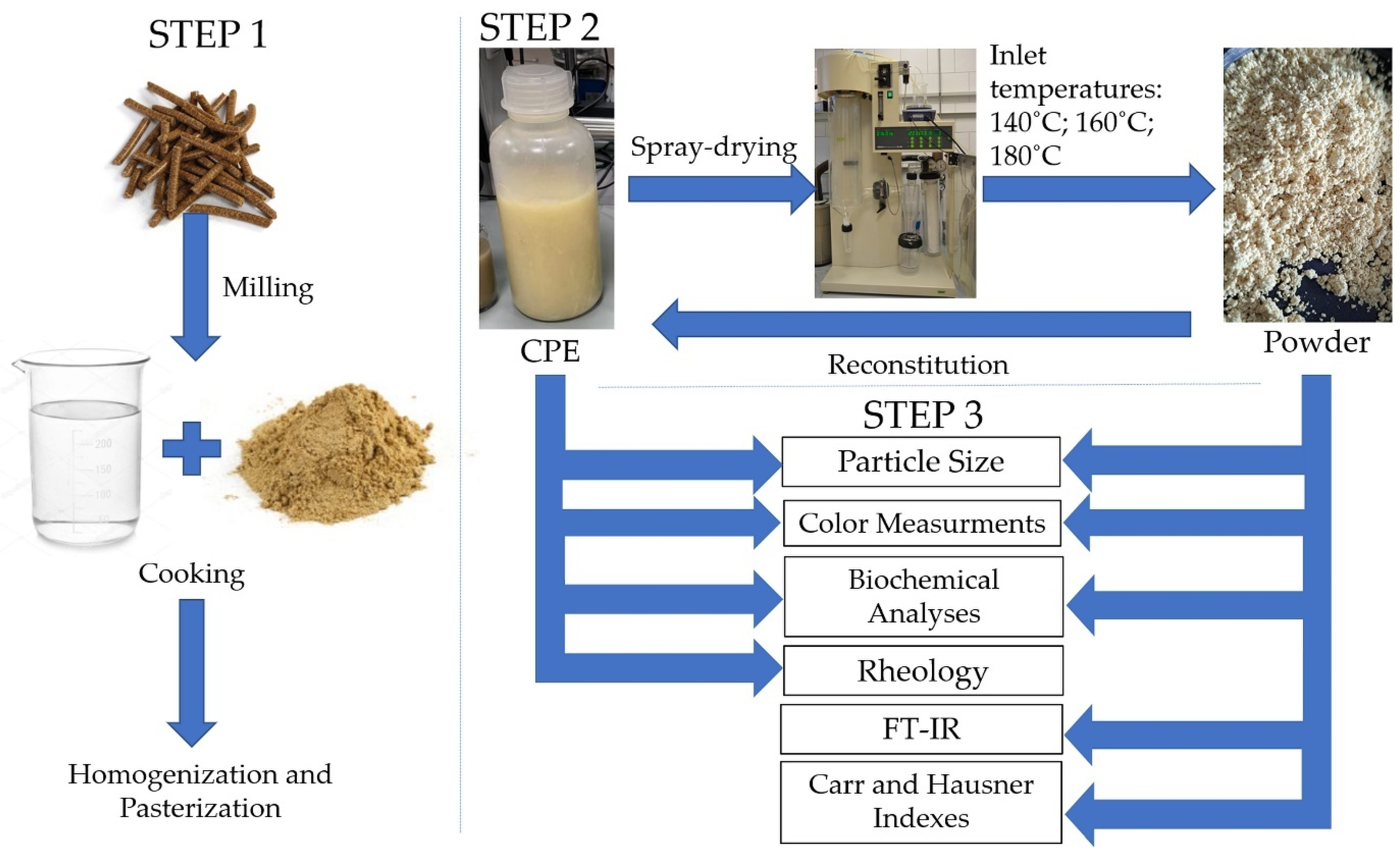
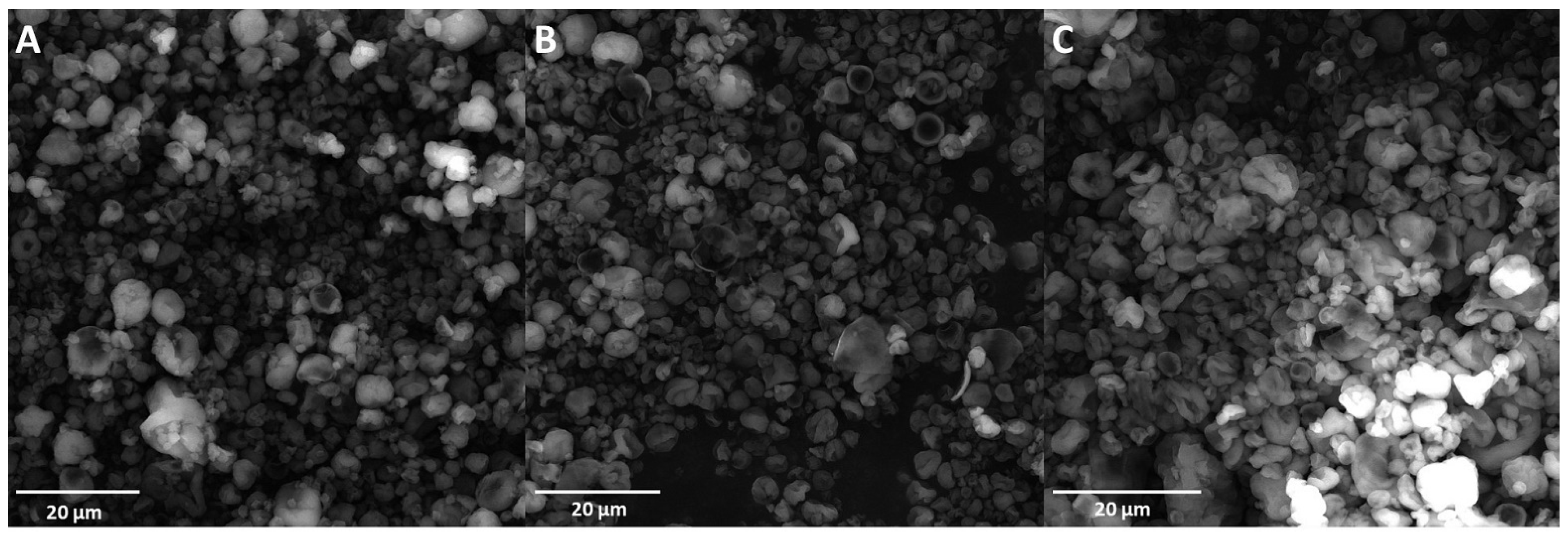
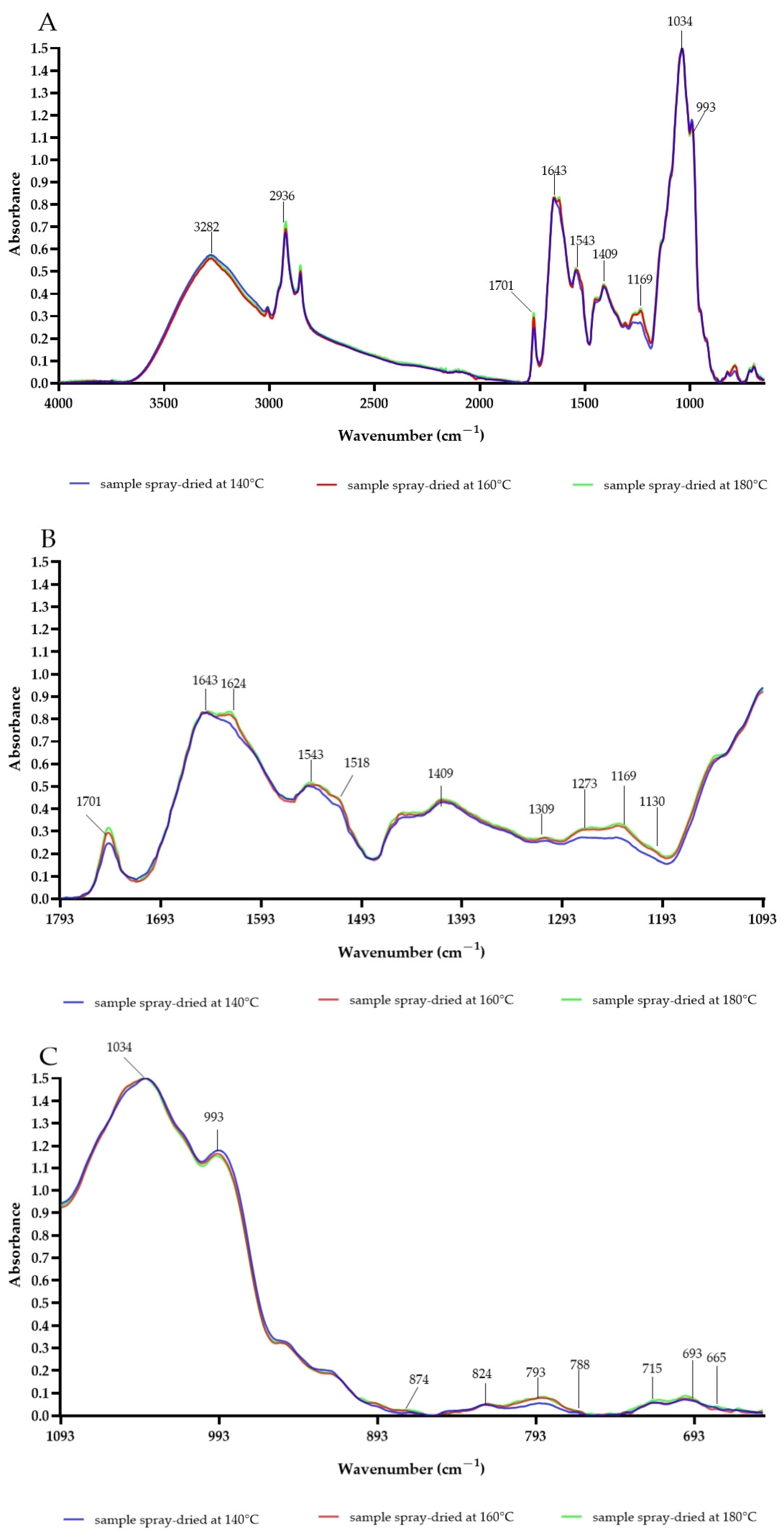
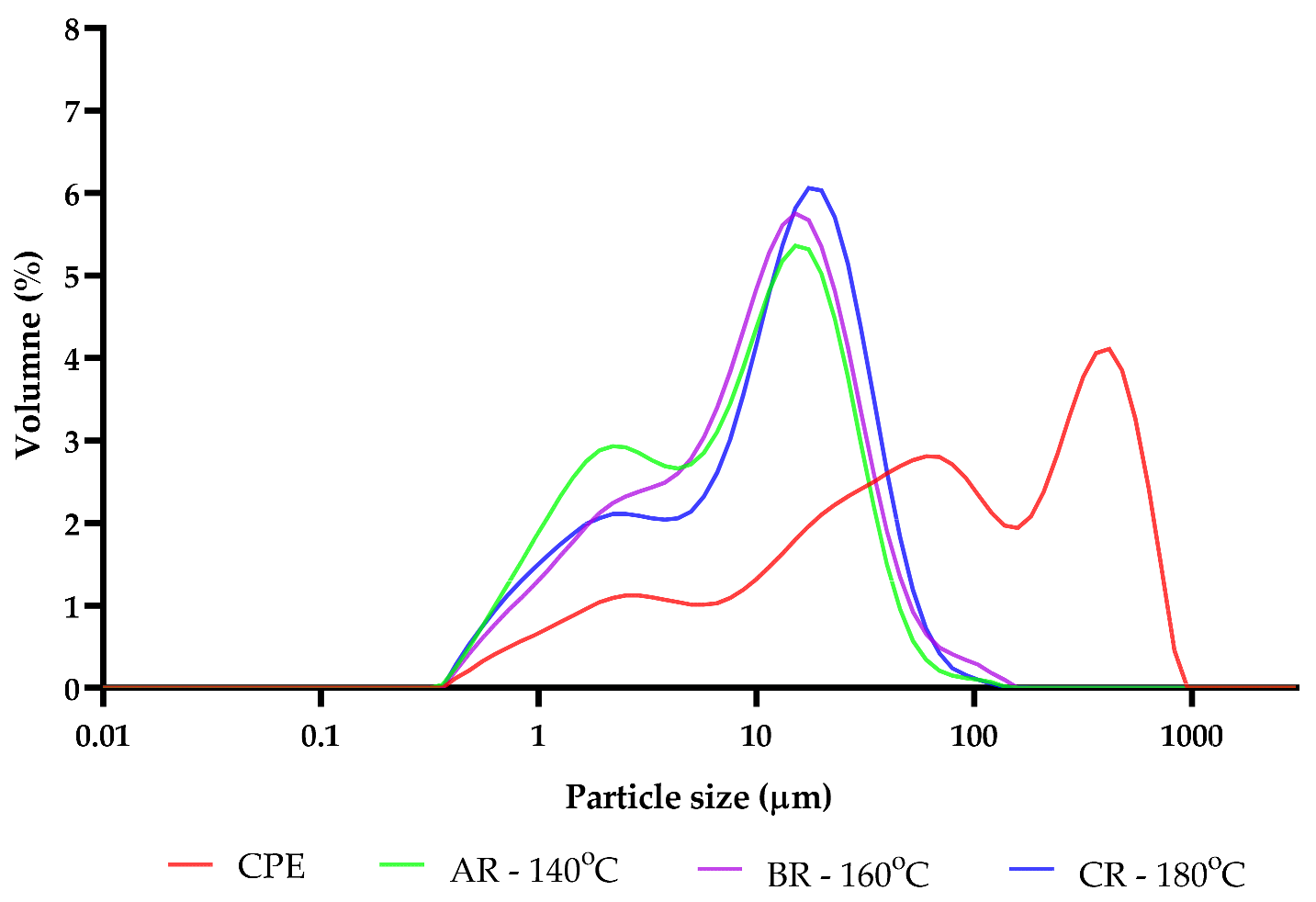
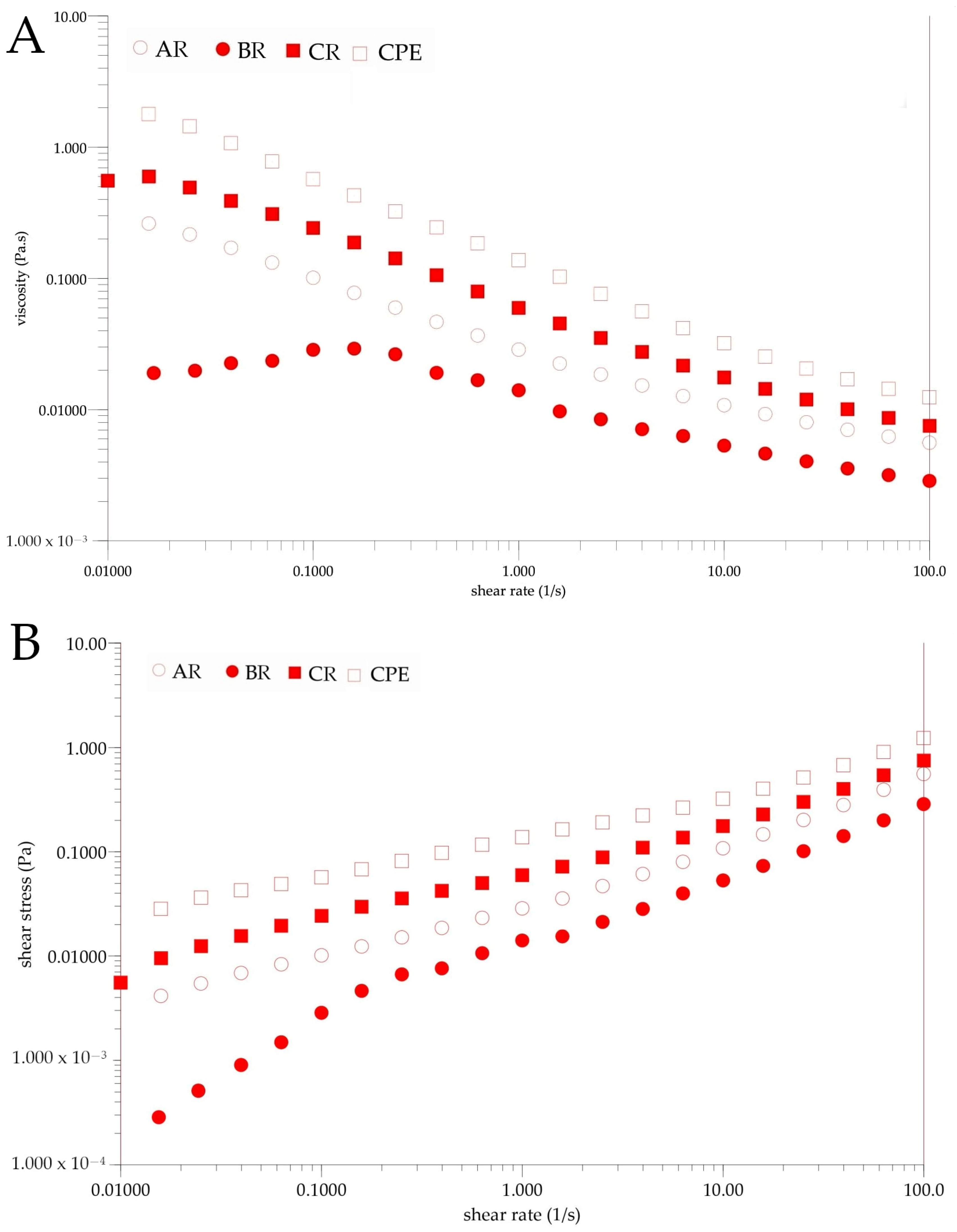
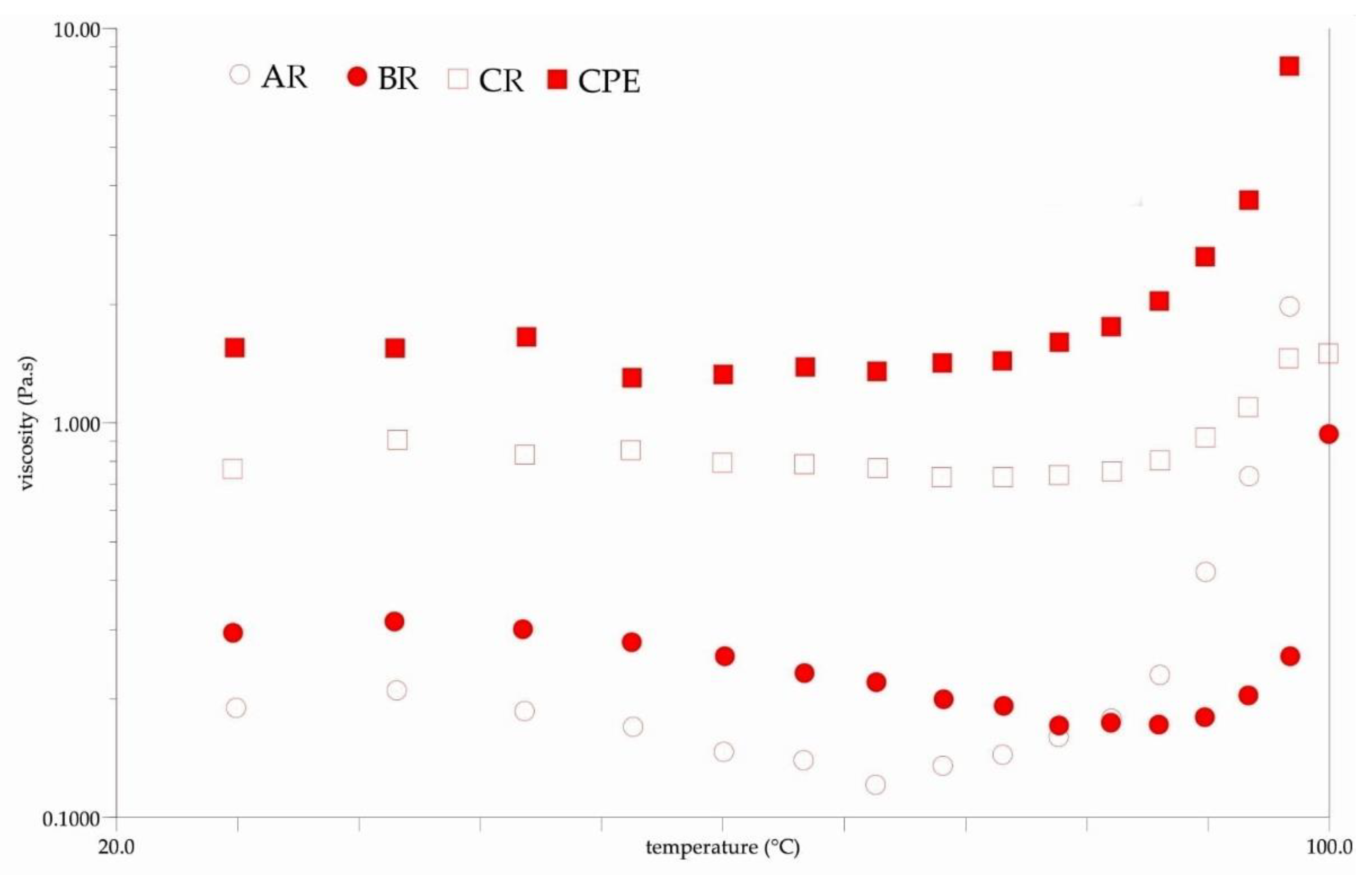
| Sample | Tapped Bulk Density (g/cm3) | HR | CI (%) | D4;3 (µm) | D3;2 (µm) | TSC (%) |
|---|---|---|---|---|---|---|
| A—140 °C | 0.382 ± 0.022 a | 1.28 ± 0.04 a | 26.83 ± 0.61 ab | 54.36 ± 1.27 a | 10.95 ± 1.09 a | 93.53 ± 0.45 a |
| B—160 °C | 0.362 ± 0.040 a | 1.37 ± 0.07 a | 27.50 ± 0.54 ab | 51.81 ± 0.55 a | 12.17 ± 0.32 b | 95.70 ± 0.19 a |
| C—180 °C | 0.364 ± 0.027 a | 1.38 ± 0.12 b | 31.63 ± 1.08 b | 41.36 ± 4.30 b | 8.55 ± 0.09 c | 97.29 ± 0.29 a |
| Sample | Solubility (%) | aw (—) | –SH (µmol/g) | –S–S– (µmol/g) |
|---|---|---|---|---|
| A—140 °C | 58.01 ± 0.45 a | 0.45 ± 0.00 a | 67.39 ± 0.19 a | 19.68 ± 0.80 a |
| B—160 °C | 70.74 ± 0.81 b | 0.37 ± 0.01 b | 74.77 ± 1.08 b | 27.61 ± 0.35 b |
| C—180 °C | 63.96 ± 0.46 ab | 0.37 ± 0.00 c | 75.66 ± 0.55 b | 47.96 ± 2.05 c |
| Available Lysine (mg/g) | FIC (FI) | TRP (FI) | FAST (%) | Melanoidins (AU) | ||
|---|---|---|---|---|---|---|
| A360 | A420 | |||||
| A—140 °C | 1.26 ± 0.02 a | 60.73 ± 2.82 a | 49.91 ± 1.14 a | 121.73 ± 2.88 a | 0.621 ± 0.003 a | 0.248 ± 0.005 a |
| B—160 °C | 1.34 ± 0.04 a | 65.21 ± 2.54 b | 54.21 ± 2.28 b | 120.29 ± 0.60 a | 0.592 ± 0.009 b | 0.198 ± 0.005 b |
| C—180 °C | 1.76 ± 0.06 b | 61.59 ± 0.16 ab | 50.57 ± 1.11 a | 123.38 ± 1.23 a | 0.567 ± 0.013 c | 0.176 ± 0.002 c |
| Sample | pH (—) | TA (%) | RSC (mg/mL) | TPC (mg GAE/mL) | TFC (mg QE/mL) | TFAA (mg Gly/mL) |
|---|---|---|---|---|---|---|
| CPE | 6.18 ± 0.01 a | 0.25 ± 0.01 a | 13.28 ± 0.02 a | 5.73 ± 0.26 a | 12.47 ± 0.01 a | 5.09 ± 0.04 a |
| AR—140 °C | 6.50 ± 0.01 b | 0.26 ± 0.01 a | 15.14 ± 0.11 b | 2.30 ± 0.09 b | 13.39 ± 0.06 b | 5.74 ± 0.02 b |
| BR—160 °C | 6.49 ± 0.00 b | 0.29 ± 0.01 a | 22.40 ± 0.00 c | 2.71 ± 0.15 c | 12.56 ± 0.09 c | 6.71 ± 0.04 c |
| CR—180 °C | 6.45 ± 0.01 c | 0.30 ± 0.01 a | 26.19 ± 0.07 d | 2.86 ± 0.20 d | 12.64 ± 0.05 d | 7.14 ± 0.01 d |
| Sample | DPPH (μmol Trolox/mL) | ABTS (μmol Trolox/mL) | FRAP (mg AAE/mL) | RP (μmol Trolox/mL) |
|---|---|---|---|---|
| CPE | 4.03 ± 0.02 a | 10.61 ± 0.33 a | 7.18 ± 0.06 a | 4.71 ± 0.01 a |
| AR—140 °C | 4.27 ± 0.01 b | 12.59 ± 0.43 b | 6.61 ± 0.02 b | 3.37 ± 0.11 b |
| BR—160 °C | 4.18 ± 0.01 c | 9.38 ± 0.43 c | 6.12 ± 0.04 c | 2.46 ± 0.08 c |
| CR—180 °C | 4.44 ±0.03 d | 9.79 ± 0.18 d | 3.94 ± 0.05 d | 2.29 ± 0.01 d |
| Powders | ||||||
|---|---|---|---|---|---|---|
| Sample | L* | a* | b* | YI | WI | BI |
| A—140 °C | 79.93 ± 0.00 a | 2.54 ± 0.00 a | 34.15 ± 0.02 a | 55.67 ± 0.04 a | 63.43 ± 0.02 a | 186.70 ± 0.00 a |
| B—160 °C | 78.87 ± 0.00 b | 1.81 ± 0.00 b | 33.56 ± 0.03 b | 60.79 ± 0.05 b | 66.08 ± 0.03 b | 186.43 ± 0.00 b |
| C—180 °C | 77.97 ± 0.00 c | 2.01 ± 0.00 c | 31.07 ± 0.03 c | 62.42 ± 0.05 c | 65.51 ± 0.03 c | 187.31 ± 0.00 c |
| Reconstituted samples | ||||||
| Sample | L* | a* | b* | YI | WI | ΔE |
| CPE | 44.40 ± 0.01 a | −5.56 ± 0.02 a | 17.29 ± 0.01 a | 55.63 ± 0.04 a | 80.37 ± 0.01 a | Used as a standard |
| AR—140 °C | 48.39 ± 0.01 b | −5.07 ± 0.02 b | 19.55 ± 0.02 b | 57.72 ± 0.05 b | 78.56 ± 0.02 b | 4.61 ± 0.01 a |
| BR—160 °C | 48.84 ± 0.01 c | −5.07 ± 0.01 b | 18.91 ± 0.01 c | 55.31 ± 0.02 c | 79.16 ± 0.01 c | 4.75 ± 0.00 b |
| CR—180 °C | 52.97 ± 0.00 d | −5.25 ± 0.01 c | 21.79 ± 0.00 d | 58.77 ± 0.00 d | 76.56 ± 0.00 d | 9.68 ± 0.01 c |
Disclaimer/Publisher’s Note: The statements, opinions and data contained in all publications are solely those of the individual author(s) and contributor(s) and not of MDPI and/or the editor(s). MDPI and/or the editor(s) disclaim responsibility for any injury to people or property resulting from any ideas, methods, instructions or products referred to in the content. |
© 2023 by the authors. Licensee MDPI, Basel, Switzerland. This article is an open access article distributed under the terms and conditions of the Creative Commons Attribution (CC BY) license (https://creativecommons.org/licenses/by/4.0/).
Share and Cite
Drozłowska, E.; Starowicz, M.; Śmietana, N.; Krupa-Kozak, U.; Łopusiewicz, Ł. Spray-Drying Impact the Physicochemical Properties and Formation of Maillard Reaction Products Contributing to Antioxidant Activity of Camelina Press Cake Extract. Antioxidants 2023, 12, 919. https://doi.org/10.3390/antiox12040919
Drozłowska E, Starowicz M, Śmietana N, Krupa-Kozak U, Łopusiewicz Ł. Spray-Drying Impact the Physicochemical Properties and Formation of Maillard Reaction Products Contributing to Antioxidant Activity of Camelina Press Cake Extract. Antioxidants. 2023; 12(4):919. https://doi.org/10.3390/antiox12040919
Chicago/Turabian StyleDrozłowska, Emilia, Małgorzata Starowicz, Natalia Śmietana, Urszula Krupa-Kozak, and Łukasz Łopusiewicz. 2023. "Spray-Drying Impact the Physicochemical Properties and Formation of Maillard Reaction Products Contributing to Antioxidant Activity of Camelina Press Cake Extract" Antioxidants 12, no. 4: 919. https://doi.org/10.3390/antiox12040919
APA StyleDrozłowska, E., Starowicz, M., Śmietana, N., Krupa-Kozak, U., & Łopusiewicz, Ł. (2023). Spray-Drying Impact the Physicochemical Properties and Formation of Maillard Reaction Products Contributing to Antioxidant Activity of Camelina Press Cake Extract. Antioxidants, 12(4), 919. https://doi.org/10.3390/antiox12040919










